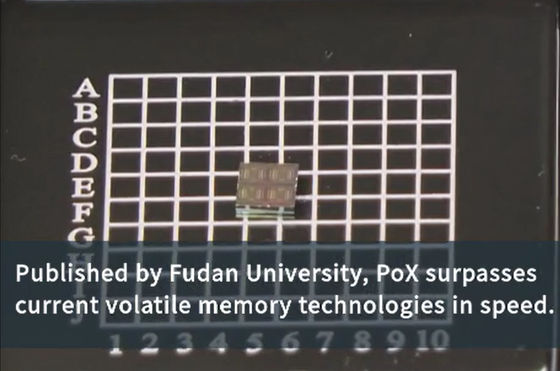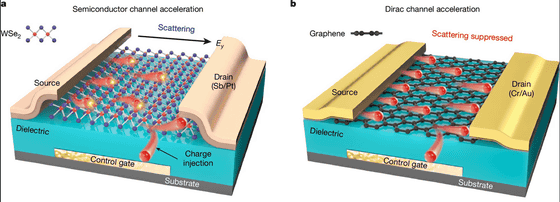The world's fastest flash memory, writable in just 400 picoseconds, has been developed

A research team at
Subnanosecond flash memory enabled by 2D-enhanced hot-carrier injection | Nature
https://www.nature.com/articles/s41586-025-08839-w
Chinese researchers achieve making world's fastest flash memory device: Nature
https://www.bastillepost.com/global/article/4760870-chinese-researchers-achieve-making-worlds-fastest-flash-memory-device-nature

Chinese scientists unveil the world's fastest flash memory device-Xinhua
https://english.news.cn/20250417/1c410ed7c8b14a74bb42e1d061a2559b/c.html
On April 17, 2025, a research team at Fudan University announced that they had developed an innovative flash memory device called 'PoX' that can store data at a speed of 400 picoseconds per bit. The fastest semiconductor storage devices reported to date took 1 to 10 nanoseconds per bit, so this is a major breakthrough. In addition, while the fastest memory devices were volatile memories that could not retain information unless power was supplied, PoX is a non-volatile memory , which makes it suitable for low-power systems. It can achieve high energy efficiency.

The feature of PoX is that it uses 'two-dimensional (2D) materials.' 2D materials are very thin materials at the atomic layer level, such as graphene, tungsten (IV) selenide, and hexagonal boron nitride (h-BN). Compared to conventional 3D materials, 2D materials have a significantly reduced thickness, excellent flexibility and transparency, and at the same time, the movement speed of carriers that carry electric charge is very high, so they are required for developing ultra-small and high-speed devices.
Below is a schematic diagram of the 2D transistor structure shown in the paper, which uses 2D materials, including a control gate at the bottom, h-BN as an insulator, and graphene and tungsten(IV) selenide for the thin body channel through which current flows.

The key to PoX research is the use of a phenomenon called ' hot carrier injection .' Hot carrier injection is a phenomenon in which electrons or carriers accelerated by an electric field have high energy and are injected across an insulator. By devising a structure using 2D materials, hot carrier injection can be used to accelerate electrons and holes along the channel while suppressing their scattering. In addition, it has been observed that the behavior of carriers in 2D materials differs depending on the material, suggesting the possibility of optimizing device performance by selecting the right material.
Liu Chunsen of the State Key Laboratory of Integrated Chip Systems at Fudan University said of PoX, 'We have now developed a small, fully functional chip. The next step is to integrate this into existing smartphones and computers. This will allow us to deploy local models on smartphones and computers without facing bottlenecks such as latency and heat caused by existing storage technologies.'
According to Liu, the calculation of large-scale AI models mainly relies on GPU chips, and while current commercial GPU chips can perform 33.5 trillion floating-point operations per second, the associated memory write and erase speeds are still limited to the microsecond (one millionth of a second) level. This speed limitation makes flash memory unsuitable for modern AI systems.
Meanwhile, PoX is precisely tailored to meet the demands of high-speed computation by GPU chips, breaking through the speed limitations of non-volatile memory storage and access. AI hardware currently consumes the majority of its energy moving data rather than processing it, but PoX can combine extremely low power consumption with ultra-fast picosecond-level write speeds, potentially helping to eliminate the long-standing memory bottleneck in AI hardware. 'The speed improvement is a major breakthrough, completely overcoming the theoretical bottleneck of existing storage technology frameworks,' Liu said of the research results.
Related Posts:
in Hardware, Posted by log1e_dh






